Romanian People's Salvation Cathedral
| People's Salvation Cathedral | |
|---|---|
| Catedrala Mântuirii Neamului | |
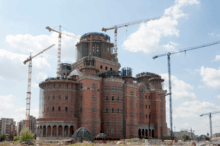 September 2018 (dom_90 m) | |
| 44°25′33.26″N 26°4′56.37″E / 44.4259056°N 26.0823250°ECoordinates: 44°25′33.26″N 26°4′56.37″E / 44.4259056°N 26.0823250°E | |
| Location | 13 September (4-60) Street, Sector 5, Bucharest |
| Country |
|
| Denomination | Eastern Orthodox |
| Website | Catedrala Neamului.ro |
| History | |
| Status | Under construction |
| Architecture | |
| Style | Neo-Byzantine |
| Groundbreaking | 10 December 2010 |
| Completed | 25 November 2018 |
| Construction cost |
€ 250 million (cathedral) € 150 million (courtyard) |
| Specifications | |
| Capacity | 6,000 (nave-narthex) |
| Length |
126.1 m (interior)[1] 135.8 m (exterior-stairs) |
| Width |
69.3 m (wall / thickness) 67.7 m (interior)[1] |
| Height |
135.0 m (ground-top cross) 124.8 m (top dome)[2] 90.0 m (bell tower/top cross) |
| Other dimensions |
323,000 m3 [3][4] 50,000 m3 (dom & pedestal) |
| Floor area |
6,200 m² [5][1][6] 7,700 m² (exterior-stairs)[5] |
| Dome height (inner) |
104.0 metres (nave floor - dom ceiling) |
| Dome diameter (outer) | 29.4 m[6] |
The People's Salvation Cathedral (Romanian: Catedrala Mântuirii Neamului) is the common name used to refer to a future Romanian Orthodox cathedral currently under construction in Bucharest. It will be the patriarchal cathedral of the Romanian Orthodox Church, and the largest Orthodox church in the world when completed by area, volume, weight and height. It is located in central Bucharest on Spirea's Hill (Arsenal Square), facing the same courtyard as the Palace of the Parliament - the world's largest administrative building for civilian use. The cathedral will be ten times smaller in size than the Parliamentary Palace, but will surpass it by 50 m in height. Also, it will be the Orthodox church with the highest inner of the nave in the world (without a dome), having 43 m from the floor to the nave's ceiling.
The People's Salvation Cathedral will have the world's largest free swinging church bell, surpassing the Saint Peter's bell (Petersglocke) in the Cologne Cathedral. With a weight of 25,190 kg, a clapper of 668 kg, a diameter of 3355 mm, a height of 3130 mm, thickness of 273 mm, the bell was cast on 11 November 2016 in Innsbruck by Grassmayr and will be elevated to 65 meters. The bell is made of 78% copper and 22% tin, both 99.99% purity and has a very low beat C3 (C0) with 130.8 Hz.[7][8][9]
The People's Salvation Cathedral will be blessed on 25 November 2018 by his holiness Ecumenical Patriarch Bartholomew I of Constantinople. The first patronal feast of the People’s Salvation Cathedral will be celebrated on 30 November, on the day of Saint Andrew the First Called, and the Liturgy will be officiated by his beatitude Patriarch Theophilos III of Jerusalem [10]. The new cathedral will be dedicated to the Ascension of Christ and to Saint Andrew the Apostle.[11][12]
History
The earliest idea of a national cathedral came about after the Romanian War of Independence (1877 - 1878). It would symbolise the victory of Orthodoxy against the Ottoman Muslims. The idea was shelved for lack of consensus on design, location and funding.[13](pp56–57)
In 1920, King Ferdinand sent a letter to the Metropolitan bishop Miron Cristea, supporting the project, but this had no effect. In 1925, after the Romanian Orthodox Church became an independent patriarchate, Cristea suggested Carol Park as a site but his idea was defeated in favour of Bibescu Vodă Square. There, in 1929, a troiță (calvary) was raised. Lack of funds meant the construction was postponed and later forgotten.[13](pp56–57)
In September 1995, as the Romanian Orthodox Church celebrated its 70th anniversary of independence, Patriarch Teoctist proposed a new large cathedral on the scale of the newly rebuilt Cathedral of Christ the Saviour in Moscow.[13](pp56–57) He envisioned a standing capacity of 10,000.
On 12 October 2004, the senate voted for the project, estimated to take 6 years.[14]
On 27 and 28 November 2004, officials, up to 1,000 priests and worshippers from Bucharest and other cities gathered in Bucharest.[15] The Holy Synod came into session. On 29 November 2007, Patriarch Daniel of Romania laid the foundation stone, gave his blessing and consecrated the site at Arsenal Hill.
Location
Three locations were proposed. In 2004, the historic area of Arsenal Hill on 13 September Avenue was selected. This area once contained two monasteries: the Mihai Vodă monastery and the Hermitage convent. There were also three parochial settlements: Albă Postăvari, Spirea Veche and Izvorul Tămăduirii which were destroyed or removed in the communist years.
The first proposed location was a park in Piaţa Unirii, where in 1998, without a proper authorization, Patriarch Teoctist laid the cornerstone of the Cathedral, in the presence of President Emil Constantinescu.[16]
During the discussions which followed, Orthodox theologians warned that, according to church's doctrine, people who want to change the purpose of a plot of land where a church is destined to be built will be anathemized. In the end, the site was not appropriate for a large building because it was the point where two metro lines crossed the Dâmboviţa River, where it was channeled underground.
The Orthodox Church next proposed Carol Park as a site, and in 2004, the Năstase government gave 5 hectares of the park to the Romanian Orthodox Church, so that the cathedral could be built in place of the Tomb of the Unknown Soldier in Bucharest and the Mausoleum of Communist Heroes.[13](pp59)[16] The Architects' Union of Romania opposed the site, arguing that it went against certain national and international laws regarding environmental protection, architecture and the protection of monuments.[17]
Following protests by local Bucharesters and opposition in the press, as well as conflicts with Traian Băsescu, the Mayor of Bucharest, the proposed site was abandoned. A new site, Izvor Park, close to the Palace of the Parliament was suggested.[17] The government of Romania granted the Church 11 hectares (27 acres) of land at this site. The Church then planned to use 5 hectares (12 acres) of the land to construct the new cathedral.[18] On 29 November 2007, a new cornerstone was laid by Patriarch Daniel.[19]
A 4,000 square metres (43,000 sq ft) plot has since been claimed by former owners of the land. (The land had been confiscated from them during the communist era).[14]
Construction
On 15 December 2010, construction of the cathedral began.[20] To build the cathedral will be used 100,000 m³ of concrete, 45,000 tons of rigid armature and about 25,000 tons of flexible armature, ten times more than a ten-storey block.[21] Energy efficiency is assured by massive walls of resistance and brick used on the inside and outside of them. The cathedral is designed to withstand earthquakes of 8.5 on the Richter scale. As of May 2016, the cathedral is constructed in a proportion of 70%.[22] The plan of the cathedral complex includes a cathedral building; below the cathedral building, a soup kitchen with capacity for 1,000; two hotels; and parking for about 500 cars. The cathedral is designed with seating for approximately 6,000 worshipers (125,000 - inner courtyard), a greater than tenfold increase on the current patriarchal cathedral.[23]
Architecture

The design of the new cathedral was debated by parties including the Romanian Senate and the Mayor of Bucharest. The winning design featured elements of architectural details from all the Romanian provinces and territories in an area that would make the cathedral complex one of the largest religious sites in the world. It was envisaged that 10,000 worshipers could stand in the main cathedral building and the whole complex could accommodate 125,000 visitors over an area of 11 hectares.[24]
The cathedral will be 126 metres (413 ft) long, 69 metres (226 ft) width, and 135 metres (443 ft) (ground level) height. The main building (three floors) would be elevated 7 metres (23 ft) with the basement area extending to 17 metres (56 ft) below the ground level. The first two levels form a main hall with a height of 11 meters, where can participate 3,000 standing worshippers. The planned ground[25] area is larger (152m by 92m / 13,668 square meters),[1] divided into spaces including a main hall, other halls and rooms for events; an icon and religious clothing shop; a workshop (for carpentry, upholstery and metal work for example); a museum, gallery-exhibition, liturgical performance media shop; as well as storage rooms, a refectory, parking access, cultic objects and an employees rooms.[26][27][28]
Opposition
The sheer size of the building drew criticism from various sources, including the French newspaper Le Figaro, which named it "a pharaonic project" and "worthy of the megalomania of Nicolae Ceauşescu".[29] Alexandru Paleologu called for the cathedral project to be stopped. He compared it to the Soviet-inspired Casa Scânteii and the House of the People, and argued "The cathedral is a catastrophic, fatal kitsch (...) an ecclesiastical Ceauşescuism (...) and parasitical, immoral and impertinent". Cristian Tudor Popescu, a journalist called the cathedral a "God mall". He said it was not churches, either big nor small, that Romania was lacking.[30]
The Romanian Orthodox Church's answer to such criticism was that the new cathedral would not imitate the gigantic buildings of the communist era, but would "correct them, through a decent and harmonious volumetry".[31]
Cost and financing
In 2006, Evenimentul Zilei estimated the cost of the new cathedral to be more than €500 million, including the price of the land.[18] In 2007, Patriarch Daniel estimated the cost of the building, excluding the land, to be approximately €400 million.[32] In 2008, Le Figaro estimated the cost to be €1 billion.[29]
In 2007, the government announced it would donate 30 million lei (€8 million) towards the construction of the new cathedral. The parliament legislated that a further half of the cost of the Cathedral would come from the state.[33] This act was criticised. Daniel Dăianu, a Liberal European MP suggested it was populist spending and funds would come from other areas of spending.[33] Remus Cernea, head of the Solidaritatea pentru libertatea de conştiinţă Association complained that funding of the cathedral with public money discriminated against others.[34]
In 2013, the cathedral construction costs were estimated at 400 million lei.[35] In 2015, five years after construction works started, the total cost for the cathedral structure without finishes was re-estimated at €91 million.[36]
Gallery
- December 2013
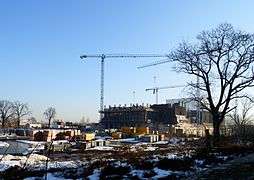 February 2014
February 2014- July 2014
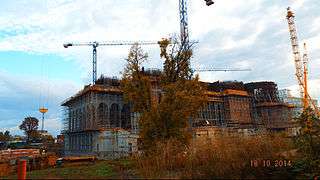 October 2014
October 2014 January 2015
January 2015- April 2015
- December 2015
- March 2016
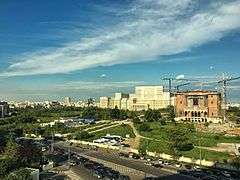 May 2016
May 2016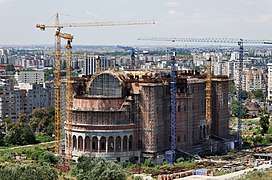 July 2016
July 2016 August 2016
August 2016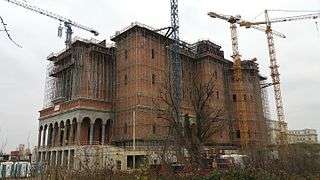 November 2016
November 2016 March 2017
March 2017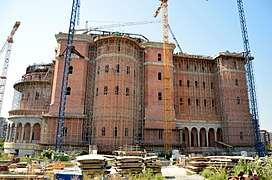 August 2017
August 2017.jpg) October 2017
October 2017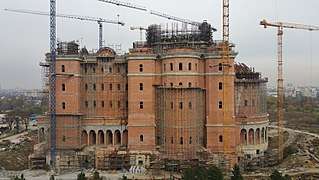 November 2017
November 2017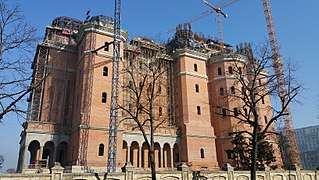 February 2018
February 2018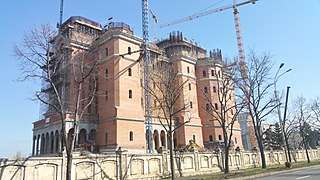 March 2018
March 2018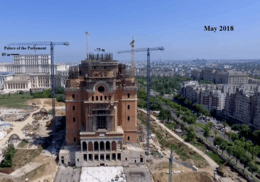 May 2018
May 2018 June 2018
June 2018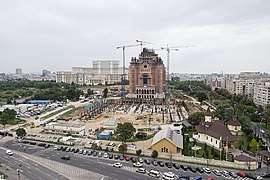 July 2018
July 2018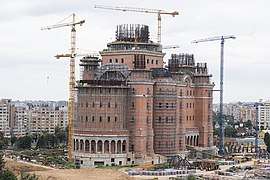 July 2018
July 2018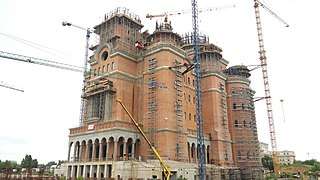 August 2018
August 2018
See also
References
- 1 2 3 4 "O CATEDRALĂ PENTRU CAPITALĂ". Patriarhia Română.
- ↑ Interior nave to the top dome is 118.0 m
The level stairs from ground is 6.8 m - ↑ Cathedral & underground ~ 532,000 m3
- ↑ "DVD - Şantierul Catedralei Mântuirii Neamului". Patriarhia Română.
- 1 2 Cathedral ~ 6,200 m² (6,8 m height from ground)
Stairs ~ 1,500 m² (4,5 m height from ground)
Cathedral & Stairs ~ 7,700 m²
Basement ~ 7,200 m² (ground)
Main building ~ 13,668 m² (underground) - 1 2 "Catedrala Mântuirii Neamului". Basilica Blog.
- ↑ "25t Grassmayr-Glocke für Bukarest". Tinmoinhat.
- ↑ "Größte freischwingende Glocke der Welt zukünftig nicht mehr in Köln (The largest free swinging bell in the world, will not be in Cologne in the future)". Wamsiedler.de.
- ↑ "Größte schwingende Kirchenglocke der Welt (Largest swinging church bell in the world)". Tirol.at.
- ↑ "Patriarhul Ierusalimului va sluji la primul hram al Catedralei Mântuirii Neamului". Basilica.ro.
- ↑ "Hramul Catedralei Mantuirii Neamului" Catedralaneamului.ro Accessed 29 November 2014.
- ↑ "Catedrala Mantuirii Neamului va purta hramul sf. ap. Andrei si al Inaltarii Domnului" Agenția de Știri Basilica Accessed 29 November 2014.
- 1 2 3 4 Stan L. and Turcescu L. Religion and Politics in Post-Communist Romania Oxford University Press, 2007, ISBN 0-19-530853-0.
- 1 2 "Punerea pietrei de temelie a Catedralei Neamului", BBC, 28 November 2007
- ↑ "Romanian People's Salvation Cathedral", Catedralaneamului.ro.
- 1 2 "Catedrala Mântuirii Neamului ar putea fi inaugurată peste şase ani", Adevărul, 26 November 2007.
- 1 2 "Unde se va construi Catedrala Mântuirii Neamului?", BBC, 4 November 2004
- 1 2 "Catedrala Zgârie-nori", in Evenimentul Zilei, 23 February 2006
- ↑ "Catedrala Patriarhală rămâne un proiect controversat." BBC, 29 November 2007
- ↑ "Bucharest's new cathedral to out-do." Romania News Watch website.
- ↑ Gheorghiţă, Elvira (4 June 2015). "Catedrala Neamului, rezistentă la cutremure de 8,5 grade, pregătită de slujbe din 2017. Galerie FOTO de pe şantier". Gândul (in Romanian).
- ↑ Gheorghiţă, Elvira (31 July 2015). "Suma impresionantă pe care Guvernul o dă pentru continuarea lucrărilor la Catedrala Neamului". Gândul (in Romanian).
- ↑ "Romania's costly passion for building churches." BBC News Accessed 7 August 2013.
- ↑ "Ansamblului Arhitectural Catedrala Mântuirii Neamului" Patriarhia.Ro
- ↑ ground and continued underground
- ↑ "Săli polivalente în subsolul Catedralei Neamului, de aceeaşi mărime cu biserica de deasupra" Gândul.Info
- ↑ "Pe cine mântuieşte Catedrala Mântuirii Neamului?" Mugetul Carpatilor
- ↑ "România în top 10 al celor mai mari edificii de cult din lume" Adevarul.ro
- 1 2 "Les projets pharaoniques de l'Église orthodoxe à Bucarest." Le Figaro 1 February 2008.
- ↑ Cristian Tudor Popescu "Catedrala Mântuirii în Țara Mântuielii." Adevărul, 23 March 2004.
- ↑ "Fericiţi cei ce construiesc biserici, nu cei ce le demolează." Romanian Patriarchy press release.
- ↑ "PF Daniel: Catedrala Mântuirii Neamului costă mai puţin decât aeroportul din Iaşi", Gândul, 29 November 2007.
- 1 2 "Catedrala Bugetului Neamului" România Liberă, 13 December 2007.
- ↑ "A doua plângere prealabilă demersului în instanţă privind acordarea de fonduri publice pentru Catedrala Mântuirii Neamului", Humanism.ro
- ↑ "Catedrala Neamului va costa 400 mil. lei, bani cu care se puteau construi 1.500 de scoli, 300 km de autostrada sau finanta 8.000 de transplanturi". InCont.ro. 23 April 2013.
- ↑ Catedrala Mântuirii Neamului - gata "la roşu" peste doi ani at romania-actualitati.ro
Sources
- Lavinia Stan, Lucian Turcescu, "Politics, National Symbols and the Romanian Orthodox Cathedral," Europe-Asia Studies, November 2006, 58 (7) pp. 1119–1139.
- Dunlop T. "Romania's costly passion for building churches." 7 August 2013. BBC News website. Accessed 7 August 2013.
External links
| Wikimedia Commons has media related to Romanian People's Salvation Cathedral. |